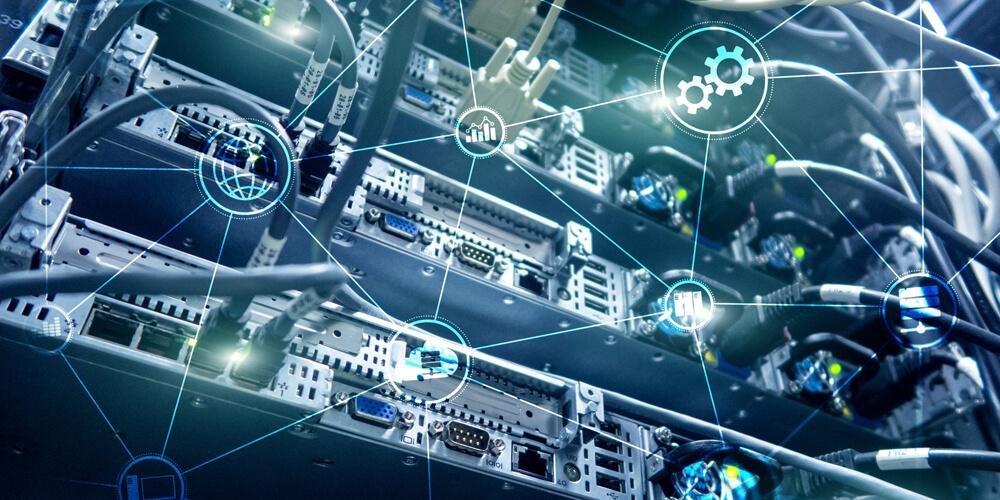June 15, 2025 | TechThrilled Newsroom
As artificial intelligence continues to redefine industries from healthcare to finance to manufacturing, one critical factor underpins its success yet remains frequently overlooked: network infrastructure. AI models are growing exponentially in size and complexity, data flows are intensifying, and latency tolerance is shrinking. All these factors combine to make robust, intelligent, and scalable network infrastructure not just helpful — but essential — to AI’s full potential.
This press release explores why modern network infrastructure is becoming the backbone of enterprise AI adoption, the challenges organizations face, key components required for success, and what leading tech companies are doing to prepare for this next-generation transformation.
The AI Surge: A New Era of Connectivity Demand
The rise of generative AI models, real-time inferencing, and AI-driven applications has triggered a surge in data consumption and distribution needs. Unlike traditional software, AI requires massive datasets for training and rapid, reliable communication for deployment.
AI systems are now:
- Distributed across hybrid cloud environments
- Dependent on real-time edge computing
- Operating on ever-larger models like GPT-4, Claude 3, and Gemini
This shift creates enormous strain on legacy networks. AI workflows require high-bandwidth, low-latency, and fault-tolerant networks to support both training and inference cycles. Even a few milliseconds of latency can affect user experience or output quality when deploying AI in critical environments like autonomous vehicles or healthcare diagnostics.
Why Traditional Infrastructure Isn’t Enough
Many enterprises began their digital transformation by upgrading storage and compute — investing in GPUs, TPUs, and high-performance servers. But without complementary investments in network infrastructure, these powerful resources cannot function optimally.
Traditional infrastructure lacks:
- Scalability to handle petabyte-scale datasets
- Flexibility to connect cloud, on-prem, and edge nodes seamlessly
- Security intelligence for real-time threat mitigation in AI pipelines
- Speed to support inference engines at scale
For example, AI-powered supply chains need real-time data from multiple vendors, sensors, and partners. If one network bottleneck slows down data transfer, the entire predictive model could become unreliable. Similarly, in media companies using generative AI for video content, even slight lag in transferring high-resolution assets between nodes can disrupt production cycles.
The Core Components of AI-Ready Network Infrastructure
To support AI workflows end-to-end, businesses must modernize network layers across data centers, edge devices, and cloud platforms. Here’s what a future-ready infrastructure stack includes:
1. High-Throughput Switching and Routing
Advanced AI workloads need multi-terabit-per-second (Tbps) switches to route data across compute nodes. Technologies like 100/400/800G Ethernet are becoming standard for high-performance clusters.
2. Low-Latency Interconnects
Tools like NVIDIA NVLink, InfiniBand, and PCIe Gen 5.0 reduce latency between GPUs and other compute elements, critical during AI training and multi-node inference.
3. Edge Networking
As AI models increasingly run on edge devices, infrastructure must support distributed compute models. This includes 5G, private LTE, and SD-WAN for seamless edge-to-core communication.
4. AI-Optimized Data Centers

Modern data centers now integrate AI into their own operations — using AI to manage AI. Smart fabrics, AI-driven cooling, and energy-efficient routing reduce infrastructure costs while improving performance.
5. Security and Observability Layers
AI introduces new risks — from poisoned training data to adversarial inputs. Network infrastructure must be intelligent, with real-time threat detection, DDoS mitigation, and full observability via tools like NetFlow, Deep Packet Inspection (DPI), and AI-integrated SIEMs.
Real-World Case Studies: Network-AI Symbiosis in Action
Healthcare: Enabling Remote Diagnosis at the Edge
In rural hospitals across India and Africa, AI-powered diagnostics tools are being deployed on edge devices. These systems analyze X-rays or CT scans locally but rely on high-speed secure networks to sync findings with cloud-based specialists in urban hospitals. A robust network ensures life-saving decisions can be made in near real-time.
Finance: High-Frequency AI Trading
Quant firms leveraging AI for real-time market prediction rely on ultra-low-latency network links between trading hubs in New York, London, and Tokyo. Even microseconds of delay can cost millions. AI models ingest and act on streaming data, meaning networks must be as fast and reliable as the models themselves.
Manufacturing: Smart Factories and Predictive Maintenance
Factories equipped with AI-driven robotics and sensor networks generate continuous streams of telemetry data. The data is sent over industrial Ethernet and 5G to centralized AI engines that detect wear-and-tear or risk anomalies. Without resilient networks, factory AI systems are rendered ineffective.
Big Tech Moves: Cloud Giants Invest in Infrastructure AI
Recognizing the bottleneck, major tech companies are now pouring billions into next-gen network infrastructure to support their AI ambitions.
Google Cloud
Launched the Cross-Cloud Network, designed to reduce AI latency between multicloud environments. It uses custom-built silicon routers to handle AI-specific data paths.
Microsoft Azure
Rolled out AI-optimized regions with InfiniBand networking across GPU clusters. Also uses AI to auto-scale network capacity based on model load prediction.
Amazon Web Services (AWS)
Expanded AWS Nitro System to reduce network overhead in AI instances, and invested heavily in Elastic Fabric Adapters (EFA) to boost model training efficiency.
Cisco
Introduced AI-native routers that predict and self-optimize traffic for inference pipelines. Cisco is also helping enterprises implement Zero Trust for AI environments to secure critical data flows.
Challenges on the Horizon: Barriers to Infrastructure Upgrades
Despite the momentum, organizations still face several hurdles in building AI-ready networks:
- Capital Costs: High-end switches, fiber deployments, and edge gear require significant upfront investment.
- Skill Gaps: Network engineers may lack AI workload optimization experience, requiring reskilling.
- Legacy Systems: Existing IT infrastructure often can’t support new AI requirements without full overhauls.
- Regulatory Constraints: Cross-border data flows critical for AI training are restricted in some regions, impacting network design.
Companies must balance the drive for innovation with operational feasibility, ensuring that infrastructure upgrades align with business goals and compliance needs.
Looking Ahead: A Unified Vision for AI Infrastructure
Experts agree that network infrastructure will evolve from a passive pipeline to an active AI participant. That means not only delivering bits faster but also understanding and reacting to AI model behaviors.
Predictions for the near future include:
- Self-Healing Networks: AI models that detect performance bottlenecks and reconfigure routes in real-time.
- Model-Aware Routing: Networks that prioritize traffic based on AI workload type (e.g., image vs. NLP).
- AI Traffic Fabric: Layered infrastructure where AI tasks trigger dedicated, optimized network paths.
- Cloud-to-Chip Optimization: Unified visibility from cloud API to GPU-level execution, minimizing friction across the pipeline.
Conclusion: No AI Without Infrastructure
The message is clear: to unlock the full value of AI, enterprises and governments must invest as heavily in network modernization as they do in model development. AI doesn’t live in isolation. It thrives in an ecosystem — and the network is its circulatory system.
From data ingestion to model inference, every step relies on robust, secure, and intelligent connectivity. Skimping on network infrastructure in the age of AI is like installing a supercomputer on dial-up.
Organizations aiming to lead in the AI-first economy must now answer a foundational question: Is your network ready for the future of intelligence?
